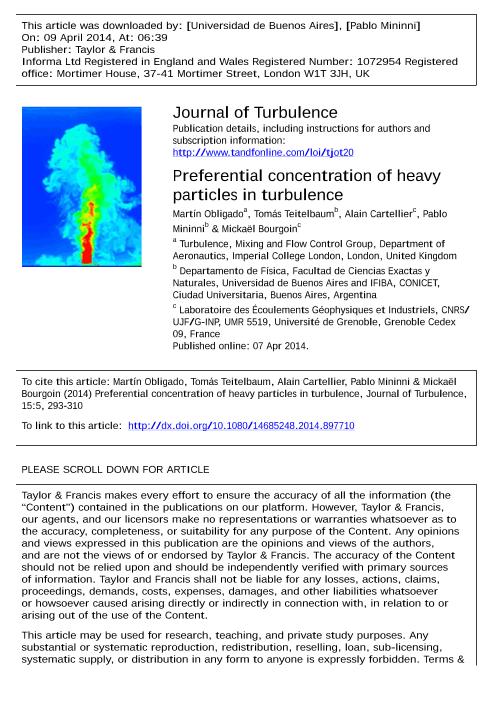Mostrar el registro sencillo del ítem
dc.contributor.author
Obligado, Martín
dc.contributor.author
Teitelbaum, Tomas

dc.contributor.author
Cartellier, Alain
dc.contributor.author
Mininni, Pablo Daniel

dc.contributor.author
Bourgoin, Mickael
dc.date.available
2017-06-09T19:20:18Z
dc.date.issued
2014-05
dc.identifier.citation
Obligado, Martín; Teitelbaum, Tomas; Cartellier, Alain; Mininni, Pablo Daniel; Bourgoin, Mickael; Preferential concentration of heavy particles in turbulence; Taylor & Francis; Journal Of Turbulence; 15; 5; 5-2014; 293-310
dc.identifier.issn
1468-5248
dc.identifier.uri
http://hdl.handle.net/11336/17905
dc.description.abstract
Particle-laden flows are of relevant interest in many industrial and natural systems. When the carrier flow is turbulent, a striking feature is the phenomenon called preferential concentration: particles denser than the fluid have the tendency to inhomogeneously distribute in space, forming clusters and depleted regions. We present an investigation of clustering of small water droplets in homogeneous and isotropic active-grid-generated turbulence. We investigate the effect of Reynolds number (Rλ) and Stokes number (St) on particles clustering in the range Rλ ∼ 200−400 and St ∼ 2−10. Using Voronoï diagrams, we characterise clustering level and cluster properties (geometry, typical dimension and fractality). The exact same Voronoï analysis is then applied to investigate clustering properties of specific topological points of the velocity field of homogeneous isotropic turbulence obtained from direct numerical simulations at Rλ ∼ 220 and 300. The goal is to compare clustering properties of actual particles with those of such points in order to explore the relevance of possible clustering mechanisms, including centrifugal effects (heavy particles sampling preferentially low-vorticity regions) and sweep-stick mechanisms (heavy particles preferentially sticking to low-acceleration points). Our study points towards a leading role of zero-acceleration points and sweep-stick effects, at least for the experimental conditions considered in this study.
dc.format
application/pdf
dc.language.iso
eng
dc.publisher
Taylor & Francis

dc.rights
info:eu-repo/semantics/openAccess
dc.rights.uri
https://creativecommons.org/licenses/by-nc-sa/2.5/ar/
dc.subject
Turbulence
dc.subject
Lagrangian Particles
dc.subject
Heavy Particles
dc.subject
Wind Tunnel Turbulence
dc.subject.classification
Física de los Fluidos y Plasma

dc.subject.classification
Ciencias Físicas

dc.subject.classification
CIENCIAS NATURALES Y EXACTAS

dc.title
Preferential concentration of heavy particles in turbulence
dc.type
info:eu-repo/semantics/article
dc.type
info:ar-repo/semantics/artículo
dc.type
info:eu-repo/semantics/publishedVersion
dc.date.updated
2017-06-09T14:15:43Z
dc.journal.volume
15
dc.journal.number
5
dc.journal.pagination
293-310
dc.journal.pais
Reino Unido

dc.journal.ciudad
Londres
dc.description.fil
Fil: Obligado, Martín. Imperial College London; Reino Unido
dc.description.fil
Fil: Teitelbaum, Tomas. Consejo Nacional de Investigaciones Científicas y Técnicas. Oficina de Coordinación Administrativa Ciudad Universitaria. Instituto de Física de Buenos Aires. Universidad de Buenos Aires. Facultad de Ciencias Exactas y Naturales. Instituto de Física de Buenos Aires; Argentina
dc.description.fil
Fil: Cartellier, Alain. Universite de Grenoble; Francia
dc.description.fil
Fil: Mininni, Pablo Daniel. Consejo Nacional de Investigaciones Científicas y Técnicas. Oficina de Coordinación Administrativa Ciudad Universitaria. Instituto de Física de Buenos Aires. Universidad de Buenos Aires. Facultad de Ciencias Exactas y Naturales. Instituto de Física de Buenos Aires; Argentina
dc.description.fil
Fil: Bourgoin, Mickael. Universite de Grenoble; Francia
dc.journal.title
Journal Of Turbulence

dc.relation.alternativeid
info:eu-repo/semantics/altIdentifier/doi/http://dx.doi.org/10.1080/14685248.2014.897710
dc.relation.alternativeid
info:eu-repo/semantics/altIdentifier/url/http://www.tandfonline.com/doi/abs/10.1080/14685248.2014.897710
Archivos asociados
